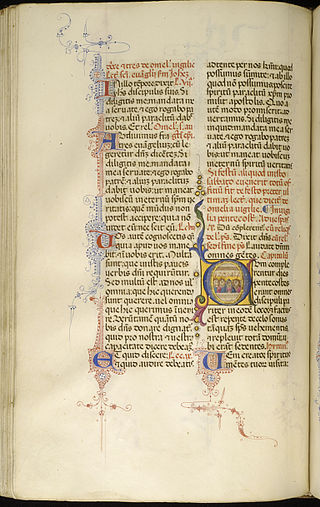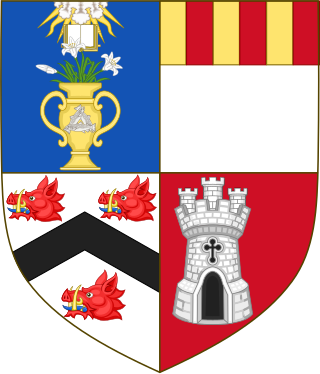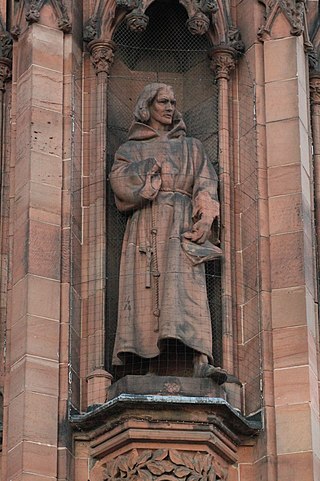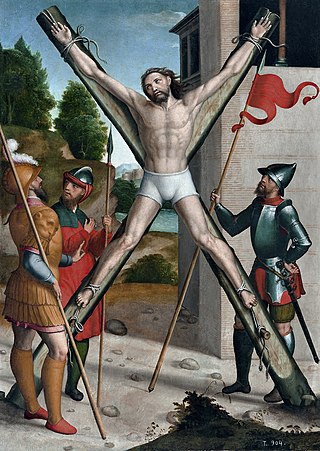
The Aberdeen Breviary (Latin : Breviarium Aberdonense) is a 16th-century Scottish Catholic breviary. It was the first full-length book to be printed in Edinburgh, and in Scotland.

The Aberdeen Breviary (Latin : Breviarium Aberdonense) is a 16th-century Scottish Catholic breviary. It was the first full-length book to be printed in Edinburgh, and in Scotland.
The creation of the Aberdeen Breviary can be seen as one of the features of the growing Scottish nationalism and identity of the early sixteenth century. [1] In 1507, King James IV, realizing that the existing Sarum Breviary, or Rite, was English in origin, desired the printing of a Scottish version. Since Scotland had no printing press at that time, booksellers Walter Chepman and Androw Myllar of Edinburgh were commissioned to “bring home a printing press” primarily for that purpose. [2]
To create the breviary itself, James sought out William Elphinstone, Bishop of Aberdeen, who had received the king's permission to establish the University of Aberdeen twelve years before. [3] To help him with the undertaking, Elphinstone, in turn, tapped the man who had helped him found the university, Scottish philosopher and historian Hector Boece. [4] The two began their work in 1509, and the first copy, produced as a small octavo, came off the press in 1510. [5]
Like the Sarum Rite, which had been in use since the twelfth century, the Aberdeen Breviary contained brief lives, or biographies, of the saints as well as the liturgy and canonical hours which were to conform to Roman practice and serve as the standard of Christian worship throughout the country. The saints’ lives, or biographies, in the breviary were all written by either Elphinstone or Boece. [5]
Boece once noted that Elphinstone collected legends of saints from every diocese in Scotland, including both national heroes and local saints. He also noted that Elphinstone devoted time to the study of ancient Scottish histories, especially in the Western Isles, where “tombs of the ancient kings” lie. In addition, some material, such as Lessons for St Cuthbert, came from the writings of Bede. Some of the collected materials were included verbatim in the breviary, and some were re-written. [6]
However, unlike the Sarum Rite, the Aberdeen work also contained lives of the nation's saints—Scottish saints such as Kentigern, Machar, and Margaret of Scotland. Indeed, historian Jane Geddes has gone so far as to call the Aberdeen Breviary a work of “religious patriotism,” pointing out Scotland's sixteenth-century efforts to establish its own identity. She writes that both Elphinstone and the king “were attempting to direct the apparently growing interest in local cults ... toward a range of saints that they identified as Scottish.” [7]
Along with focusing on Scottish saints, Elphinstone sometimes “Scotticized” Irish and continental saints, one of the most interesting being the office of an Irish missionary in France named Fiacre. Historian Steve Boardman speculates Fiacre appealed to the Scots because of their traditional military alliance with France and long history of wars against the English Crown. Furthermore, the Irish-born French saint is associated with the death of England's invading King Henry V. [8] After the Battle of Agincourt, Henry had allowed his army to pillage Fiacre's monastery and Christian pilgrimage shrine in the town bearing his name, but Fiacre supernaturally prevented the English soldiers from carrying their loot beyond the boundaries of his monastery. Henry V died of haemorrhoids on 30 August, St Fiacre's feast day. [9]
Boardman points out, however, that there are a few cases in which Elphinstone and Boece included saints associated with Scotland, but introduced as otherwise. One example is St Constantine the Great, for whom there were dedicated places of worship in Scotland—at Kilchousland in Kintyre and at Govan—and whom Glasgow even claimed as a native son. [10]
The breviary, which was composed in Latin, includes at the back a small, 16-page book entitled Compassio Beate Marie, which has readings about the relics of St Andrew, Scotland's patron saint. [2] In addition, at the end of each volume were the Propria Sanctorum, containing prayers and readings to be used only on the feast day of the particular saint. [11] Hymns, responsories, and antiphons were composed for most of the saints in various metres and styles. There are poems as well, although, except for the poem for the office of St Fiacre, they are not high in quality. All these were to be used as acts of worship. [12]
Only four copies of the Aberdeen Breviary are extant: one in the University of Edinburgh; one in the Library of the Faculty of Advocates, Edinburgh; one in the library of King's College, Aberdeen; and one recently purchased by the National Library of Scotland from the private collection of the Earl of Strathmore in Glamis, Angus. [5] [2]
A facsimile of one copy was published in two parts (Pars estiva and Pars hyemalis) in 1854 & 1855, edited by William Blew; this facsimile was issued to members of the Bannatyne, Maitland and Spalding Clubs. [13] The copy held by the University of Edinburgh has been entirely digitised, and is available for viewing online. [14]

The Roman Breviary is a breviary of the Roman Rite in the Catholic Church. A liturgical book, it contains public or canonical prayers, hymns, the Psalms, readings, and notations for everyday use, especially by bishops, priests, and deacons in the Divine Office.

The University of Aberdeen is a public research university in Aberdeen, Scotland. It was founded in 1495 when William Elphinstone, Bishop of Aberdeen and Chancellor of Scotland, petitioned Pope Alexander VI on behalf of James IV, King of Scots to establish King's College, making it one of Scotland's four ancient universities and the fifth-oldest university in the English-speaking world. Along with the universities of St Andrews, Glasgow, and Edinburgh, the university was part of the Scottish Enlightenment during the 18th century.
This article contains information about the literary events and publications of 1510.

William Dunbar was a Scottish makar, or court poet, active in the late fifteenth and early sixteenth centuries. He was closely associated with the court of King James IV and produced a large body of work in Scots distinguished by its great variation in themes and literary styles. He was probably a native of East Lothian, as assumed from a satirical reference in The Flyting of Dumbar and Kennedie. His surname is also spelt Dumbar.

Hector Boece, known in Latin as Hector Boecius or Boethius, was a Scottish philosopher and historian, and the first Principal of King's College in Aberdeen, a predecessor of the University of Aberdeen.

William Elphinstone was a Scottish statesman, Bishop of Aberdeen and founder of the University of Aberdeen.

The Use of Sarum is the liturgical use of the Latin rites developed at Salisbury Cathedral and used from the late eleventh century until the English Reformation. It is largely identical to the Roman Rite, with about ten per cent of its material drawn from other sources. The cathedral's liturgy was widely respected during the late Middle Ages, and churches throughout the British Isles and parts of northwestern Europe adapted its customs for celebrations of the Eucharist and canonical hours. The Sarum Rite has a unique ecumenical position in influencing and being authorized for liturgical use by the Roman Catholic Church, Eastern Orthodox Church, as well as the Anglican Communion.
Christian liturgy is a pattern for worship used by a Christian congregation or denomination on a regular basis. The term liturgy comes from Greek and means "public work". Within Christianity, liturgies descending from the same region, denomination, or culture are described as ritual families.

King's College in Old Aberdeen, Scotland, the full title of which is The University and King's College of Aberdeen, is a formerly independent university founded in 1495 and now an integral part of the University of Aberdeen. Its historic buildings are the centrepiece of the University of Aberdeen's Old Aberdeen campus, often known as the King's or King's College campus.
The Use of York or York Rite was a liturgical use of the Roman Rite – itself a Latin liturgical rite – practised in part of northern England, prior to the reign of Henry VIII. During Henry's reign the Use of York was suppressed in favour of the Use of Sarum, developed at Salisbury Cathedral, followed by the Book of Common Prayer. "Use" denotes the special liturgical customs which prevailed in a particular diocese or group of dioceses; it is one of the medieval English uses, together with the Use of Sarum, the Use of Hereford, and the Use of Bangor.
Saint Fergus was a bishop who worked in Scotland as a missionary.

Latin liturgical rites, or Western liturgical rites, is a large family of liturgical rites and uses of public worship employed by the Latin Church, the largest particular church sui iuris of the Catholic Church, that originated in Europe where the Latin language once dominated. Its language is now known as Ecclesiastical Latin. The most used rite is the Roman Rite.
Fetternear Bishop's Palace is an archaeological site of what was one of the palaces of the medieval bishops of Aberdeen. It is near Kemnay in Aberdeenshire. Later, a ruined tower-house and mansion of Fetternear House were built on part of the site.
Balthere of Tyninghame was a Northumbrian hermit and abbot, resident in East Lothian during the 8th century.

The Catholic Church in Scotland overseen by the Scottish Bishops' Conference, is part of the worldwide Catholic Church headed by the Pope. After first arriving in Roman Britain, being reintroduced by both the Hiberno-Scottish mission and Iona Abbey, and firmly established in Scotland for nearly a millennium, the Catholic Church was outlawed by the Scottish Reformation Parliament in 1560. Multiple regime change uprisings in the interim failed to reestablish Catholicism or, in the case of the Jacobite risings, freedom of religion. Even today, the Papal Jurisdiction Act 1560, while no longer enforced, still remains on the books.

Androw Myllar was the first Scottish printer.

The Chepman and Myllar Press was the first printing press to be established in Scotland.

Walter Chepman was a Scottish merchant, notary and civil servant active in the late fifteenth and early sixteenth centuries. Chepman served at the Scottish court during the reigns of James IV and James V. In partnership with Androw Myllar he established Scotland's first printing press in 1508. Chepman was also a significant patron of Saint Giles' Kirk in Edinburgh.

Canon Alexander Galloway was a 16th-century cleric from Aberdeen in Scotland. He was not only a Canon of St Machar's Cathedral, he was a Royal Notary and Diocesan Clerk for James IV and James V of Scotland; vicar of the parishes of Fordyce, Bothelny and Kinkell (1516-1552); five times Rector of King's College – University of Aberdeen; Master of Works on the Bridge of Dee in Aberdeen and for Greyfriars Church in Aberdeen; and Chancellor of the Diocese of Aberdeen. According to Steven Holmes, he was one of the most notable liturgists of his time, designing many fine examples of Sacrament Houses across the North-East of Scotland. He was a friend of and adviser to Hector Boece, the first Principal of the University of Aberdeen, as well as Bishop Elphinstone, Chancellor of Scotland and Gavin Dunbar. He was an avid anti-Reformationist being a friend of Jacobus Latomus and Erasmus and clerics in the Old University of Leuven. Along with Gavin Dunbar, Galloway designed and had built the western towers of the cathedral and designed the heraldic ceiling, featuring 48 coats of arms in three rows of sixteen. More than anyone else he contributed to the development of the artistry of Scottish lettering. He has a claim to be what some might call "a Renaissance Man".

St. Lesmo of Glen Tanar is the name given to a holy hermit who it is believed lived in Glen Tanar Aberdeenshire Scotland in the eighth century. He is recorded by Thomas Dempster as a "saint" in the seventeenth century. His claimed Saints’ Day is 9 December.